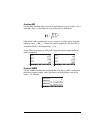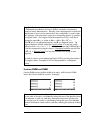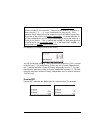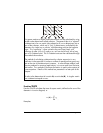
Page 11-12
For example, try finding the rank for the matrix:
You will find that the rank is 2. That is because the second row [2,4,6] is equal
to the first row [1,2,3] multiplied by 2, thus, row two is linearly dependent of
row 1 and the maximum number of linearly independent rows is 2. You can
check that the maximum number of linearly independent columns is 3. The rank
being the maximum number of linearly independent rows or columns becomes
2 for this case.
Function DET
Function DET calculates the determinant of a square matrix. For example,
where the values d
j
are constant, we say that c
k
is linearly dependent on the
columns included in the summation. (Notice that the values of j include any
value in the set {1, 2, …, n}, in any combination, as long as j≠k.) If the
expression shown above cannot be written for any of the column vectors then
we say that all the columns are linearly independent. A similar definition for
the linear independence of rows can be developed by writing the matrix as a
column of row vectors. Thus, if we find that rank(A) = n, then the matrix has
an inverse and it is a non-singular matrix
. If, on the other hand, rank(A) < n,
then the matrix is singular
and no inverse exist.


















